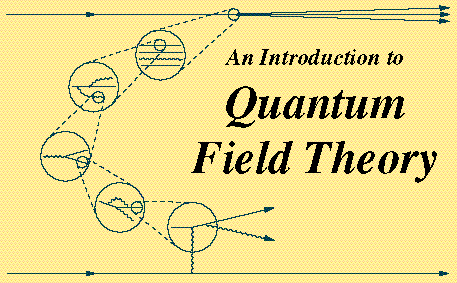

Overview
An Introduction to Quantum Field Theory is a textbook
intended for the graduate course covering relativistic
quantum mechanics, quantum electrodynamics, and Feynman diagrams. The
authors make this subject accessible through carefully worked examples
illustrating the technical aspects of the subject, and intuitive
explanations of what is going on behind the mathematics. After
presenting the basics of quantum electrodynamics, the authors discuss
the theory of renormalization and its relation to statistical
mechanics, and introduce the renormalization group. This discussion
sets the stage for a treatment of non-Abelian gauge theories and their
use in describing the fundamental interactions of elementary particles.
Contents (summary)
Corrections to the book are contained in
a separate web page. To view
that page,
click here.
Wondering how we typeset those complicated contraction expressions with TeX?
Click here to download our contraction macros.
We're not particularly proud of 'em, but they worked for us.
Last modified on October 17, 2005.
Preface xi
Notations and Conventions xix
Part I: Feynman Diagrams and Quantum Electrodynamics
1 Invitation: Pair Production in e+e- Annihilation 3
2 The Klein-Gordon Field 13
3 The Dirac Field 35
4 Interacting Fields and Feynman Diagrams 77
5 Elementary Processes of Quantum Electrodynamics 131
6 Radiative Corrections: Introduction 175
7 Radiative Corrections: Some Formal Developments 211
Final Project: Radiation of Gluon Jets 259
Part II: Renormalization
8 Invitation: Ultraviolet Cutoffs and Critical Fluctuations 265
9 Functional Methods 275
10 Systematics of Renormalization 315
11 Renormalization and Symmetry 347
12 The Renormalization Group 393
13 Critical Exponents and Scalar Field Theory 439
Final Project: The Coleman-Weinberg Potential 469
Part III: Non-Abelian Gauge Theories
14 Invitation: The Parton Model of Hadron Structure 473
15 Non-Abelian Gauge Invariance 481
16 Quantization of Non-Abelian Gauge Theories 505
17 Quantum Chromodynamics 545
18 Operator Products and Effective Vertices 599
19 Perturbation Theory Anomalies 651
20 Gauge Theories with Spontaneous Symmetry Breaking 689
21 Quantization of Spontaneously Broken Gauge Theories 731
Final Project: Decays of the Higgs Boson 775
Epilogue
22 Quantum Field Theory at the Frontier 781
---------------
Appendix: Reference Formulae 801
Bibliography 811
Index 817